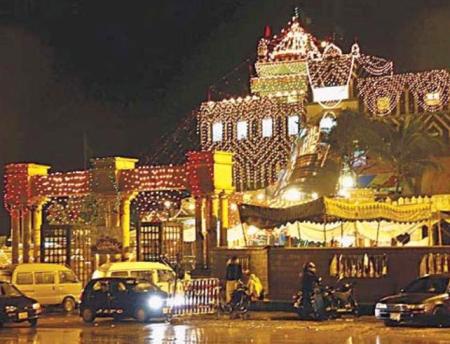
Annual Uras of the Tomb of Abdullah Shah Ghazi clifton Karachi starting from today.The Tomb Decorate Beautifully.
Annual URS of Saiyyad Abdullah Shah Ghazi is being celebrated at the at his tomb overlooking the Arabian Sea in Clifton. The Ghazi?s urs, or three day death anniversary, is observed every year from the 20th till the 22nd of Zilhaj: this year the anniversary coincides with the 19th, 20th and 21st of December.
The government has largely rebuilt the shrine and its surroundings may appear unrecognizable to someone who has not visited in the past few years.
Though the Ghazi?s shrine ? lit up with majestic fairy lights, buntings and decorated with ribbons for the urs ? is a magnet for all kinds year-round, during the urs the number of visitors swells significantly. As one parks his vehicle in the newly constructed parking lot (Rs10 into the coffers of the Auqaf Department, thank you very much) one notices dilapidated tents set up on the sides of the lot, perhaps to house devotees who have come from afar. Largely on foot, a cross-section of people are making a beeline towards the staircase leading to the tomb chamber.
There are amply bearded men, their fin gers encrusted with bejewelled rings, ajraks or anghochas slung over their shoulders. There are veiled women with small armies of children in tow. There are young girls wearing painfully loud shades of lipstick. There are even a few men in sharp, well-cut suits, heads covered with either prayer caps or handkerchiefs, climbing the stairwell ? still wet from yesterday?s rain ? to honour the Ghazi. Malangs and urchins make up the rest of the crowd.
On the way to the staircase, a stall invites ?real? devotees of the Ghazi to purchase audio-video cassettes of odes in honour of the saint, while another stall announces that langar, or free food offered by devotees, will be available at a certain time, so be there or be square. Out of respect for the holy place, one must remove one?s shoes afore ascending the stairway. The board says there?s a Rs2 charge, but the shoe-keeper will charge Rs3 instead. Take it or leave it.
On the way to the tomb, after passing the office of the Auqaf Department, one notices several graves while there is a place for ablution. One inhales a heady blend of incensefilled smoke coming from sticks lit by devotees just before entering the tomb. Inside, there is a constant flow of devotees. They enter ? segregated gender-wise ? and move into the inner tomb chamber.
Outside the tomb chamber, devotees are busy in dhikr, or remembrance. Most of the males are deep in thought while others are rhythmically chanting religious formulae. The women are quieter, most apparently seeking the intercession of the Ghazi with God, others reciting the Holy Qur?an. In a corner a board gives the historical background of the Ghazi.
It says he was born in the 98th year after the Hijra, and left this world in 151 AH. It says his name was Abdullah, his kunya or surname was Abu Mohammad and his title was al-Ashtar. As for his lineage, it is said that the Ghazi was a descendant of Imam Hasan Ibne Ali (AS), thus making him a Hasani Saiyyad, or member of Holy Prophet?s (PBUH) family.
The plaque says Abdullah Shah was termed ?ghazi?, or victor, as he lived during times of strife, as this was the period when the Umayyads and Abbasids were locked in a bloody struggle for power.
One is not sure of the veracity of all the historical facts stated on the plaque, as this writer has not come across any scholarly study done on the life of Abdullah Shah Ghazi.
After the quick history lesson, one proceeds inside the inner tomb chamber to offer fateha and pay respects to the Ghazi. Outside the inner chamber, opposite the tomb is a tiny prayer niche where the faithful can offer their canonical prayers.


0 comments:
Post a Comment